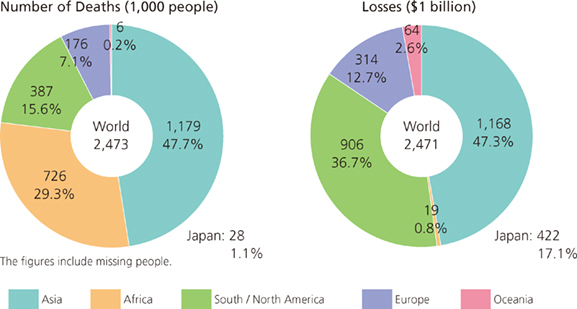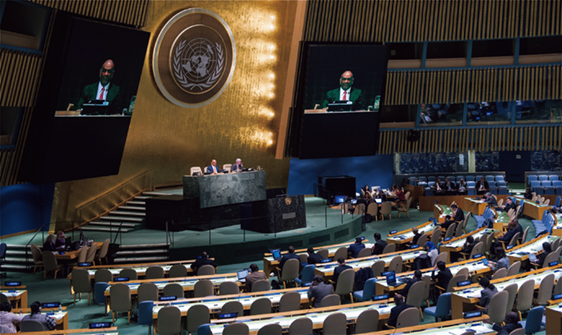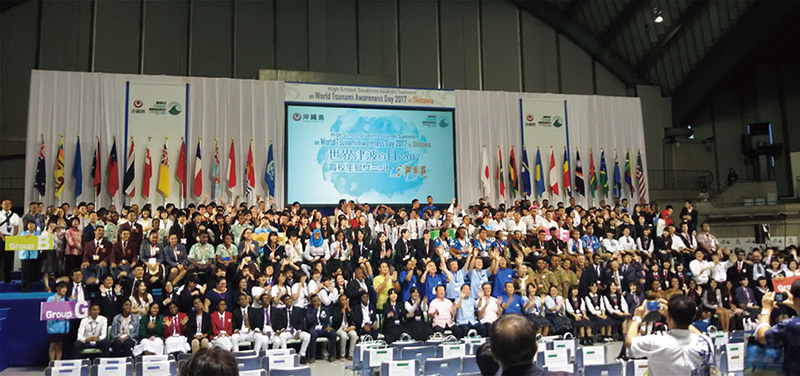ODA Topics 5
Japan's Disaster Risk Reduction Cooperation and the “High School Students Islands Summit on World Tsunami Awareness Day 2017 in Okinawa”
Over the ten year period from 2005 to 2014, approximately 700,000 people lost their lives due to natural hazards throughout the world, and the total economic loss reached approximately $1.3 trillion. Furthermore, as shown in the graph below, the Asian region where Japan is located accounts for nearly half of both the deaths and financial damages from natural hazards in the world.


(Vote to adopt “World Tsunami Awareness Day” at the 70th General Assembly of the United Nations)
At the 70th General Assembly of the United Nations held in December 2015, a resolution jointly proposed by 142 countries including Japan was adopted by consensus to designate November 5 as “World Tsunami Awareness Day” in order to raise awareness of the threat of tsunamis and strengthen tsunami countermeasures worldwide.
The date of November 5 was selected for “World Tsunami Awareness Day” based on the anecdote “Inamura no Hi” (fire on heaves of rice). On November 5, 1854, in the late Edo period, when the Ansei-Nankai Earthquake centered on the Kii Peninsula and Shikoku region occurred, Goryo Hamaguchi, the leader of Hiro village, (currently Hirogawa Town in Wakayama Prefecture) predicted the tsunami using traditional knowledge and saved the lives of villagers by setting fire to his sheaves of rice as an early warning and thus helping them evacuate to a higher ground. Even after the earthquake, he spent four years building the coastal embankment to protect villages from future tsunamis using his own fortune. At the time of the Showa-Nankai Earthquake, which occurred 92 years after the Ansei-Nankai Earthquake, the embankment protected the people from the subsequent tsunamis.
Japan has experienced various types of natural hazards due to its geographical condition. However, that has allowed Japan to lead international society in terms of practicing “Build Back Better,” which aims to build a more resilient society through numerous support measures by using past experience and knowledge in the field of disaster risk reduction. Recognizing the “World Tsunami Awareness Day” as momentum, Japan will further promote international cooperation in disaster risk reduction. The “High School Students Summit on World Tsunami Awareness Day” is one of the pillars for Japanese assistance in disaster risk reduction.

(Opening ceremony of the High School Students Islands Summit on “World Tsunami Awareness Day” 2017 in Okinawa)
This summit is a youth exchange program that invites high school students from countries which are susceptible to a tsunami to study Japanese history of tsunamis and disaster risk reduction initiatives in each country together with Japanese high school students in order to pass the experience and lessons onto future generations. Following the first summit held in Kuroshio Town, Kochi Prefecture in November 2016, the second summit, entitled the “High School Students Islands Summit on World Tsunami Awareness Day 2017 in Okinawa” (organized by Okinawa Prefecture and the Okinawa Prefectural Board of Education) was held on November 7-8, 2017 in Ginowan City, Okinawa Prefecture. High school students from 26 countries including Japan and island nations participated in the summit. Japan's only island prefecture, Okinawa, was severely damaged by the great tsunami in 1771, which is said to have been one of the largest in the world, and still there are many tsunami stones remaining in various areas of Okinawa today. These high school students are from island nations with a similar natural environment to that of Okinawa. The Ministry of Foreign Affairs of Japan was in charge of the invitation program for overseas high school students to participate in the summit.
Before the day of the summit, the high school students visited Miyako Island and Ishigaki Island to inspect the disaster risk reduction centers and tsunami stones and to communicate with the local high school students.
At the summit, a total of approximately 255 students from 26 countries had a lively discussion with regards to disaster risk reduction under the overall theme of the summit, “We want to protect people's lives – Let's do what we can now upon learning and preparing for the threat of tsunami. Send the message of “Yui Maaru” spirit from the island of Bankoku Shinryo (Bridge between Nations)” (“Yui Maaru” is a local Okinawan word expressing the spirit of mutual support). As an outcome of the summit, the students announced an “Ambassador's Note” which compiled specific action plans for disaster risk reduction, and each high school student expressed his/her will to work as future leaders for disaster risk reduction in their own region under the spirit of Yui Maaru.
The summit was an extremely meaningful experience for the high school students of each country who learned about and deepened their understanding of the threat of natural disasters such as tsunamis as well as disaster risk reduction initiatives. The high school students who participated in the summit are expected to take leadership roles in the future in the field of disaster risk reduction to minimize the damage of earthquakes and tsunamis. Japan will continue to contribute to international society by providing assistance for the development of the young leaders in disaster risk reduction in order to save as many precious lives as possible from disasters.
